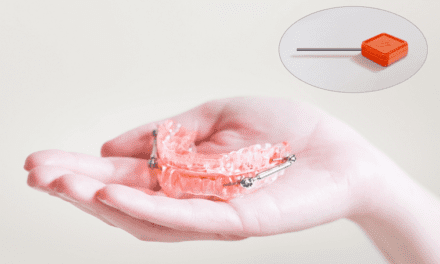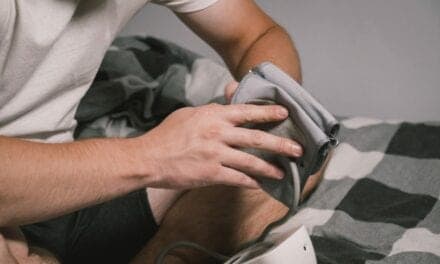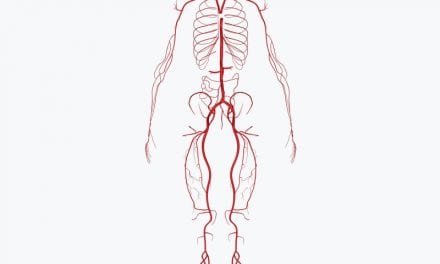Before otolaryngologist Eric A. Mair, MD, FAAP, FACS, became an adjunct clinical professor at the University of North Carolina at Chapel Hill, he spent a number of years as an ENT surgeon in the US Air Force. He became interested in snoring treatments when a soldier walked into his office with an official letter of reprimand. His offence: snoring.
During a military exercise, although he was more than a kilometer away, the soldier had given his camp’s position away to the enemy by his loud snoring. In other cases, Mair treated soldiers who were hurting morale by disturbing the sleep of fellow soldiers.
While primary snoring is not clinically a disease, it is a serious social disorder for both the military and the home. As a result, it is also big business on the Internet. A myriad of Web sites offer miraculous, noninvasive products to reduce or eliminate snoring for $5 to $150—including shipping and handling if you buy now!
Physicians may easily dismiss alternative snoring therapies that involve pillows, magnets, and acupressure watches. Consumers, however, remain uneducated about therapies that work and those that waste time and money.
MAGNETS, AND RINGS, AND PILLOWS, OH MY!
Despite increasing awareness of OSA, many consumers turn to the Internet for seemingly quick-fix solutions for snoring. These products have little or no objective clinical evidence behind them beyond user testimonials. However, most Web sites caution consumers that their products are not a cure for sleep apnea and that snoring may be a symptom of OSA.
|
Subscribe to Sleep Report to receive updates about snoring and OSA treatment |
To address the exponential growth of questionable antisnoring therapies, Mair and another Air Force medical colleague, Peter G. Michaelson, MC, conducted a randomized clinical trial, which evaluated three of the most popular Internet cures:
- An oral spray lubricant applied before bedtime;
- A nasal strip designed to maintain nasal valve patency; and
- A head-positioning pillow.
Mair explains, “We took those three [products] and bought home sleep studies. We used the Snap Test, which has a way of measuring the sound and 4A transformations, so you can tell exactly how loud the noise is, and it measures the snoring noise.”
The results of the randomized protocol, published in Otolaryngology—Head & Neck Surgery, showed that there was neither objective nor subjective benefit to the use of the tested popular noninvasive antisnore aids.
The authors write, “Palatal snoring, palatal loudness, average loudness of snoring, averaged palatal flutter frequency, and respiratory disturbance index did not significantly change when comparing the three snoring aids with no treatment. Subjective comments and complications are reviewed, as well.”1
OTHER BIZARRE SNORING AIDS
Although Mair’s research revealed the ineffectiveness of some breathe strips, pillows, and lubricating sprays, there are many more devices and formulas on the market that claim to be a nonsurgical, antisnore remedy that works.
“I have patients who come into my office and say what about this, what about that? But you go back and look in the medical literature, and there’s no randomized controlled study on any of them. Yet, these companies advertise and can get by the FDA because primary snoring is not a real disease. So, it’s not regulated at all, and without FDA standards, patients can give testimonials that it’s the best thing ever.”
Mair laments that as soon as a trial is published about these far-fetched remedies, a new crop of antisnoring aids appear on the Web. He says, “You really have to stay ahead of the game. It’s definitely a Buyer Beware sort of market.”
Antisnoring aids include many devices that present themselves as either technological innovations, holistic innovations—or both. Some of the common bizarre devices include:
- Acupressure pinky rings. There are many of these products. All utilize prongs on the inside of a pinky ring. The manufacturers claim that these prongs and the ring’s sterling silver material somehow activate the “heart meridian,” and increase “energy flow” or what homeopaths call “Chi.”
- The “SnorEnder” is a head-to-chin elastic band with magnets and padding around the ears. The band wraps around the head and ears, harnessing the chin, essentially holding the jaw shut and discouraging mouth breathing. Magnets and padding activate acupressure points around the head that affect Chi.
- There are several watch devices, all of which claim to “retrain” the body to stop snoring by first detecting the sound of snoring. Once snoring is detected, the watch emits a gentle electronic shock to the wrist that supposedly trains the body to switch body positions.
Makers of these alternative devices often claim that they have conducted “scientific trials,” but later reveal that these are anecdotal trials using written user evaluations.
ALTERNATIVES WITH SOME CLINICAL EVIDENCE
In the past 2 years, oral appliances (OAs) have been accepted by the AASM as an alternative to CPAP for those with mild to moderate sleep apnea.
Custom OAs are perhaps the most accepted noninvasive antisnoring alternative to surgical intervention or CPAP. But there are several other noninvasive techniques. None have a great deal of peer-reviewed clinical evidence, but there is some. For example:
Singing. A small British pilot study of 20 patients enlisted participants to perform specific singing exercises intended to tighten throat tissues that contribute to snoring. Subjects used a voice-activated tape recorder for 7 nights before and after performing exercises.
According to the study, non-overweight patients who accurately performed the exercises 20 minutes per day showed the best improvement.2 According to the inventor’s Web site (singingforsnorers.com) and the BBC, the results were promising enough for the Otolaryngology Department at The Royal Devon & Exeter Hospital, UK, to conduct a randomized controlled study to further evaluate the exercises.3
Playing the Didgeridoo. Along the same theory as singing exercises, playing the didgeridoo also may tighten throat tissues and subsequently reduce snoring. A randomized controlled trial published in the British Medical Journal4 enlisted 25 snorers to practice the didgeridoo for around 25 minutes per day, while those in the control group remained on a supposed waiting list.
Using the Epworth Sleepiness Scale as well as measuring AHI and other quality of life measures, the researchers found a significant improvement over the control group. “The combined analysis of sleep related outcomes showed a moderate to large effect of didgeridoo playing (difference between summary z scores -0.78 SD units, -1.27 to -0.28, P <0.01). Changes in health related quality of life did not differ between groups.”4
A Banana Shake. Yes, a banana shake. A study from the University of New England in New South Wales, Australia, was presented at an April 2009 conference of the Thoracic Society of Australia and New Zealand. News reports in Australian media say that these researchers have taken a step toward using the phospholipids in a bedtime banana smoothie to reduce choking risk in sleep apnea.5
According to the news reports, researchers theorized that phospholipids, which are known for keeping the throat open, could be used to help open the airway in apnea patients. Bananas contain phospholipids, but the researchers did not know whether the phospholipids would stay in the mouth during sleep.
To find out, the researchers followed eight women who each consumed 130 grams of ripe banana before sleep. The women were subsequently checked for phospholipids and showed that the phospholipids remained present in the mouth after 6 hours of sleep. If the banana was blended into a smoothie, a larger amount of phospholipids was detected.
The next phase of the study will research the effects of this banana on CPAP patients with OSA. It is theorized that a banana smoothie consumed before CPAP therapy could reduce positive airway pressures, but there was no indication on whether the researchers will test the banana’s effect on primary snoring
Perhaps, if the Australian studies on phospholipids prove to be effective, in a few years, treatment will all come down to a banana shake. Yum.
Tor Valenza is a staff writer for Sleep Review.
REFERENCES
- Michaelson Peter G, Mair Eric A. Popular snore aids: do they work? Otolaryngol Head Neck Surg. 2004;130:649-58.
- Ojay A, Ernst E. Can singing exercises reduce snoring? A pilot study. Complement Ther Med. 2000;8(3):151-6.
- news.bbc.co.uk/1/hi/england/devon/4633787.stm.
- Puhan MA, Suarez A, Lo Cascio C, Zahn A, Heitz M, Braenli O. Didgeridoo playing as alternative treatment for obstructive sleep apnoea syndrome: randomised controlled trial. BMJ. 2006;332:266-270. doi:10.1136/bmj.38705.470590.55 (www.bmj.com/cgi/content/full/332/7536/~).
- www.newkerala.com/nkfullnews-1-16757.html.





